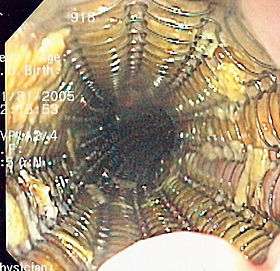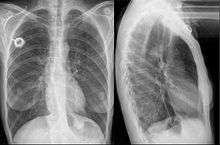Esophageal stent
An esophageal stent is a stent (tube) placed in the esophagus to keep a blocked area open so the patient can swallow soft food and liquids. Esophageal stents may be self-expandable metallic stents, or made of plastic, or silicone, and may be used in the treatment of esophageal cancer.
| Esophageal stent | |
|---|---|
 Esophageal stent |
A 2007 study showed no difference in the quality of palliation between plastic and metal stents, but a novel polyester mesh stent caused more complications, especially migration.[1]
As of 2009, covered self-expanding metal stents were the only FDA-approved to be placed permanently. Occasionally, these stents may be placed as part of a clinical trial or as off-label use to repair esophageal leaks or fistulae. They are placed using the guidance of fluoroscopy (x-ray) and endoscopy. Usually, they are left in for less than four weeks.
Additional images

References
- Conio M, Repici A, Battaglia G, et al. (2007). "A randomized prospective comparison of self-expandable plastic stents and partially covered self-expandable metal stents in the palliation of malignant esophageal Dysphagia". Am. J. Gastroenterol. 102 (12): 2667–77. PMID 18042102.
External links
- Esophageal stent entry in the public domain NCI Dictionary of Cancer Terms
![]()